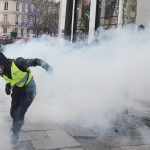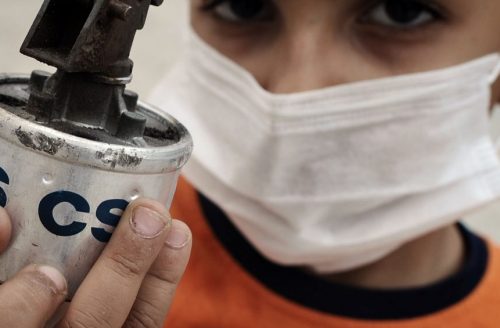For decades, the use of tear gas for crowd control has been fiercely debated. Over the past month, we’ve seen the conversation renewed, with unabated “yellow vest” protests in Paris, which have turned violent in a cloud of tear gas, and in the United States, where Customs and Border Protection fired smoke canisters at a group of asylum seekers who tried to cross the U.S.-Mexico border. The photographs and video that emerged from the border incident caused an outcry largely because it showed women and children – some pictured barefoot and in diapers – caught up in the melee.
It’s not only the optics of these incidents that are alarming, but also the real dangers which tear gas poses to people’s health – something which is often underreported. Tear gas – a class of weapon with several different chemical propellants and delivery methods – can be very harmful, and the use of these chemical weapons is widespread and increasing. While tear gas is intended to be used to protect public safety, it is frequently used to repress the rights to assembly and free speech.
As an emergency physician, I have seen my fair share of patients with significant trauma, but it is only in rare instances that the patient’s ailment affects my own health. A few years ago, I took care of a young man who had experienced pepper spray. While I was examining him, I felt burning on my skin and teary eyes, and I even had trouble breathing. It was only after about 30 minutes of flushing with water and breathing fresh air that either of us felt better. It was terrifying, and the memory has stayed with me ever since.
I have subsequently treated many more cases involving tear gas and pepper spray – evidence of how these weapons are being more frequently used. Some argue that it is better to use these weapons than to engage in lethal gunfire, but it’s important to consider that all weapons, including tear gas, can cause severe harm and can even be lethal.
The research my colleagues and I have done into these weapons has shown that, beyond the known effects of causing tearing and pain, tear gas can also cause chemical burns, allergic reactions, corneal injury, and respiratory distress, as well as blunt force trauma if the person is directly hit by the canister. There have been deaths, especially when the tear gas is used in enclosed spaces or against particularly vulnerable people.
Tear gas, by nature, is indiscriminate, and affects everyone within its reach – from those who may initiate a protest, to peaceful bystanders, to children caught up in the chaos, to law enforcement officers themselves. Young children, or those with asthma or respiratory disorders, and those who may not be able to run away quickly, are particularly at risk of serious injury. And those with previous skin, eye, or gastrointestinal problems can suffer amplified symptoms. When tear gas is used in enclosed spaces, excessive quantities are fired, or the canisters are targeted directly into a crowd or at a person, rather than at the outskirts of a gathering, these injuries can be significantly exacerbated. Symptoms can sometimes persist for long periods of time and certain individuals may be permanently disabled.
As an advocate for my patients, and as someone who has felt the symptoms herself, I feel obligated to point out the significant health consequences of tear gas and other crowd-control weapons. At a time when vulnerable asylum-seeking families are seeking to have their voices heard, it’s important to remember that all people have the right to assemble and speak their minds. They should be allowed to peacefully protest and voice their opinions, without compromising public safety, and without the fear of being exposed to these potentially deadly weapons.
Read PHR’s factsheet about chemical irritants here.


